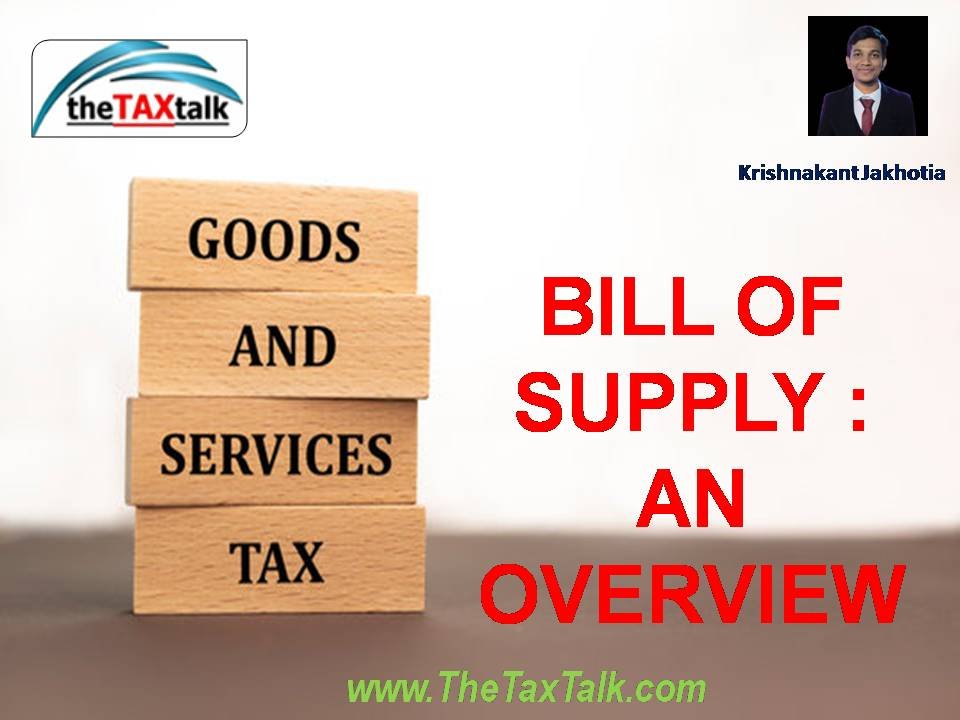![]()
A business registered under GST issues a tax invoice to the buyer. Such an invoice mentions the GST rate charged on the goods and services sold. However, some businesses registered under GST cannot charge any tax on the invoice issued by them. Such dealers have to issue a Bill of Supply. A Bill of Supply is issued when GST is not applicable on a transaction or when GST is not to be recovered from the customers.
A bill of supply should be issued instead of a tax invoice in case a registered person supplying exempted goods or services or both or a registered person is paying tax the under composition scheme. A bill of supply does not contain any tax amount as the seller cannot charge GST to the buyer. A bill of supply is evidence of tax-free supply and the taxes cannot be collected from the buyer of goods or services.
Who can issue Bill of Supply?
A.Composition Dealer
A taxpayer whose turnover is less than Rs 1.5 crores* (Rs. 75 lakhs for north-east states and Uttarakhand) can opt for composition scheme. A dealer opting for composition scheme has to deposit tax on their receipts themselves, they are not allowed to collect any tax from their buyers. The GST has to be paid out of pocket by the composition dealer. They cannot charge GST in the invoice. Thus a composition dealer has to raise a Bill of Supply instead of a Tax Invoice. The composition dealer has to mention the words ‘composition taxable person not eligible to collect taxes on supplies’ on the Bill of Supply.
B.Exporters
Export supplies are zero-rated, hence an exporter is not required to charge GST on their invoice. Thus, a registered taxpayer who is exporting goods can issue a Bill of Supply in place of a tax invoice. However, the exporter is required to mention the following in their Bill of Supply-
- “Supply meant for export on payment of IGST”
- “Supply meant for export under bond or Letter of Undertaking without payment of IGST”
C. Exempted Goods Supplier
The CBIC has issued a list of goods and services that are exempted from GST. When such goods or services are supplied by a registered supplier, a bill of supply is issued instead of a tax invoice.
For instance, when a registered taxpayer supplies handloom, they have to issue a Bill of Supply instead of a tax invoice.
Content of Bill of supply
Now we will understand the content of Bill of supply.
- Name, address & GSTIN of supplier
- Unique Serial No. for a financial year (not exceeding 16 characters)
- Date of issue
- Name, address & GSTIN of the recipient
- HSN code in case of goods or SAC code in case of services
- Description of goods or services
- Value of supply (after discount, if any)
- Signature or electronic signature
- Now we will understand the content of Bill of supply.
What are some relaxations in the case of a Bill of supply?
- Value less than Rs. 200: If the value of the goods or services, or both, is less than Rs. 200, a bill of supply is not required to be issued.
- Signature or digital signature is not necessary: When a bill for supply is issued digitally or online, no signature or electronic signature is required. We frequently come across bills that include a statement.“A computer created this invoice. This does not necessitate signature.”
- Relaxation for serial No & address of customer: Due to the massive volume of transactions in the banking, insurance, and passenger transportation sectors, taxpayers are not required to save the client’s address and serial number.
- Deemed Bill of Supply: In the case of a non-taxable supply (such as petroleum or alcoholic liquor), a tax invoice or other documentation produced in addition to any other act shall be considered a Bill of Supply.
- Consolidated Bill of Supply: If the value of the products or services given is less than Rs. 1200, a separate Bill of Supply is not necessary if the buyer does not require one. At the end of each day, a consolidated Bill of Supply can be issued to each receiver separately.
- Invoice-cum-bill of supply: When a registered person supplies both taxable and exempted goods or services, he might issue a single ‘Invoice cum bill of supply.’
- Relaxation in the case of HSN Code or SAC:HSN codes are eight digits long, whereas SAC codes are six digits long. Relaxation is provided for the number of digits in the HSN code, which is listed below:
| Turnover | |
| Less than Rs. 1.5 crore | HSN code not required |
| Between Rs.1.5 crore – Rs. 5 crore | 2-digit HSN |
| Above Rs. 5 crore | 4-digit HSN |
From,
Krishnakant Jakhotia
Mobile No :-9422507911
Emali Id :-taxtalknew@gmail.com




